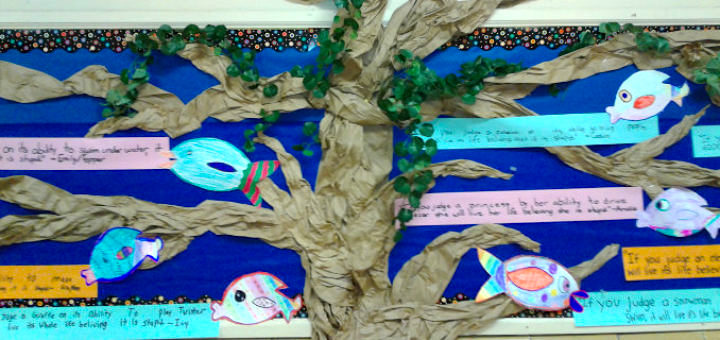Getting to Know New Kids, Characters and Fish
A MiddleWeb Blog
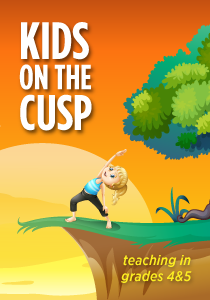 I had every intention of beginning the Global Read Aloud on time this year.
I had every intention of beginning the Global Read Aloud on time this year.
GRA had been firmly cemented in my plan book since early summer, when I’d first met Amal, on the pages of Amal Unbound by Aisha Saeed. Amal is a young girl living in a mercilessly controlled area of Pakistan.
Amal’s story is, to say the least, foreign to the students I teach in suburban New Jersey. The kids in Room 4T are nine and ten years old and are quite naïve when it comes to the overt savagery that exists in our world. The riptide of hatred has proven to be deadly and unforgiving out there in the open seas. Yet, it is my responsibility to help prepare them for this world, vast and vicious as it can show itself to be.
The kids in 4T don’t know what it’s like to be denied an education like Amal was, and none of them have ever been forced into indentured servitude (although a few of the wise guys in our room would claim that doing homework qualifies as indentured servitude).
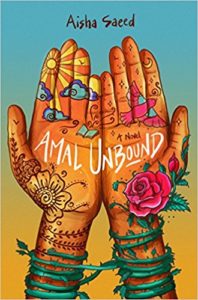
A month was surely plenty of time to finish reading Fish in a Tree by Lynda Mullaly Hunt. We would wrap up our time with Ally Nickerson, Hunt’s self-doubting young protagonist, just in time to meet Amal.
September is surprisingly short
As it turns out, September is a lot shorter than it looks on a calendar. October 1st quickly crept up on us. I didn’t want to panic. What was the worst that could happen? There was no rule that I had to start GRA on time, was there?
I needed a moment to think, to come up for air and just tread water, to get my bearings again, to get a good look around for a possible solution on the horizon. Coming to the surface, leaving the stressors of time frames and deadlines lurking beneath me in the depths, allowed me to see that there was already big stuff happening in our room, especially on the read-aloud rug. This is where we’d been getting to know Ally, our fish in her tree…and getting to know each other, as well.
These days in 4T, there are far more kids with what author Lynda Hunt refers to as “learning differences.” Ally was a perfect character to begin our year with. Ally was a fish swimming a little closer to our home, her struggles were a little closer to our own experiences. She was easier to connect with than a Pakistani girl living across two oceans from us. I knew a novel that hit closer to home would enable my students to make more obvious connections which would allow me to get to know each of them a little better.
My friend Joe (who had planned far better than I for the GRA October 1st start date) recommended Fish in a Tree this past summer. At the time, I hadn’t known that it was a GRA selection in 2015. I must admit, I found some solace in this as I was coming to terms with my own inability to meet this year’s projected start date.
“If you judge a teacher by her ability to manage time, she will go through life believing that she is somehow less than.”
We have a “Wall of Wisdom” in 4T. It’s been up for a few years now. This year’s first wisdom points out that, “Even Einstein asked questions.”
So we began Fish in a Tree with the memorable quote from Albert himself. I simply projected Einstein’s powerful words up on our interactive white board and asked the kids to respond. Einstein states very simply:
“If you judge a fish by its ability to climb a tree, it will live its whole life believing that it is stupid.”
Nine year olds get it. They know what it’s like to be judged by a bar that is seemingly impossible to meet. The friends we met through Fish in a Tree reminded us not to judge ourselves too harshly based on a bar that’s been set by somebody else.
Understanding dyslexia
Hunt’s powerful tale also showed us that quirky is cool and that the impossible can become possible. In response, we came up with some creative “Einsteinisms” of our own, as we did our best to step into Ally’s shoes and imagine what it would be like to have dyslexia. One of my favorites was, “If you judge a coffee bean on its ability to make tea, it will live its whole life believing that it is stupid.”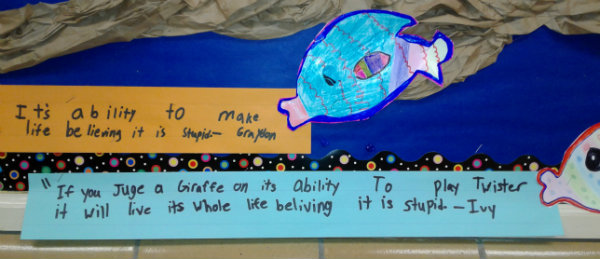
I also administered a fake sentence dictation test. The kids had to use their non-dominant hands while I dictated complex sentences at an obnoxiously rapid pace, repeating each sentence just two times before quickly moving to the next. Their embellished protests and dramatic whining were quite entertaining!
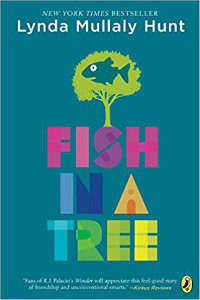
And by getting to know Ally, we’d gotten to know each other as well, through discussions and connections made on the read-aloud rug, and by pondering quotes by Einstein, along with some other wise sayings written by the creative and curious thinkers in 4T.
Looking forward to a character facing different challenges
My hope was to participate in the Global Read Aloud on time this year, with Aisha Saeed’s young yet mighty heroine Amal. We will meet Amal. Ally Nickerson just borrowed us for a while. She had an important story to share too.
I know Pernille Ripp, the creative spark behind a world-wide read aloud, won’t mind. I knew this even before I scrambled to the GRA site for reassurance. I was comforted when I saw her words.
“I hope that this journey is one that is worth your time….make it work for you…Don’t sweat the small things and just enjoy the ride.”
The students in 4T are finding many moments to, as Pernille puts it, “sit and listen to incredible stories…in quiet and wonder, and then have meaningful conversations that maybe, just maybe, will help them see the world as filled with human beings who deserve our understanding, kindness, and support.”
And even though Amal’s world is oceans away from us, I know the kids will respond to her once they meet her.
The world is a really big pond these days, and my students are already swimming around in it. Technology gives us quick access to distant worlds and many schools filled with different fish. My students need to meet them. They need to get to know some of these other fish, to prepare for a life at sea.
Here are a few teaching resources to help you dive in:
This quote on page 2 of Fish in a Tree made me so sad… “Teachers are like the machines that take quarters for bouncy balls. You know what you’re going to get. Yet, you don’t know, too.”
…but this link is a message to teachers from Hunt herself. It made me feel much, much better…once I’d finished that happy kind of crying that we do.
This Fish in a Tree lesson, a free resource by Penguin, gave 4T a lot of fish food to nibble on and discuss.
Heather Marshall’s collection of Novel Hyperdocs is a resource I used as more of a presentation tool (because I am still working on being tech savvy). “If you judge a teacher on her ability to incorporate new and unfamiliar tech into her classroom without any formal training, she will forever go through life believing she is behind the times.”
Beth Sandford created this great teaching tool for Hunt’s book.

